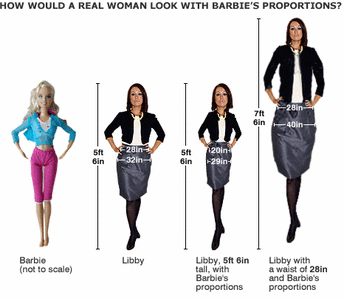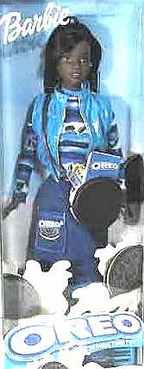It's a Weighting Game
We have all at one point wanted to be just like them: tan, fit, famous, and… plastic. Mattel, for years has been attacked by many people saying that Barbie promotes an unrealistic body image for women. In 1963 Barbie Baby-sits outfit was released and came with a booklet entitled How to Lose Weight. On the back cover was printed “Don’t eat” which can be found in an article done by BBC news (What Would a Real Life Barbie Look Like). Also, according to Finland's University Central Hospital, if Barbie was brought from her 1/6 scale to life size (see picture on right), her dimensions (height, bust, and waist) would still lack 17-22% of the body fat needed for menstruation (What Would a Real Life Barbie Look Like).
The article also goes on to say that 1 in 100,000 women would actually have Barbie’s body type-so the perfect Barbie body is not impossible,but rare (What Would a Real Life Barbie Look Like). How many people feel the need to have the perfect Barbie body just by playing with the doll? An interview with a Purdue student revealed, when asked if she ever felt any pressure to look like Barbie: she states “No, I never felt any pressure on me, I was playing”. So yes, Barbie has a very unrealistic body but she is after all a doll. So maybe when it comes to the real people who love and play with her they know they are just as beautiful. Below is a video about how to get the perfect plastic look. Does this mean that Barbie may be causing too much of an influence on women's image of themselves?
The article also goes on to say that 1 in 100,000 women would actually have Barbie’s body type-so the perfect Barbie body is not impossible,but rare (What Would a Real Life Barbie Look Like). How many people feel the need to have the perfect Barbie body just by playing with the doll? An interview with a Purdue student revealed, when asked if she ever felt any pressure to look like Barbie: she states “No, I never felt any pressure on me, I was playing”. So yes, Barbie has a very unrealistic body but she is after all a doll. So maybe when it comes to the real people who love and play with her they know they are just as beautiful. Below is a video about how to get the perfect plastic look. Does this mean that Barbie may be causing too much of an influence on women's image of themselves?
Lawsuit
From the BBC: Mattel has not been the only one getting the heat over Barbie. In 1997 musical artist Aqua came out with their hit single “Barbie Girl”. Mattel sued MCA records for copyright infringement and for sullying the good name that was Barbie. But the courts ruled in favor of the artist saying "With Barbie, Mattel created not just a toy but a cultural icon," he said. "With fame often comes unwanted attention” (Barbie Loses Battle over Bimbo Image).

This picture demonstrates how unrealistic Barbie's proportions are and how they would look on the average woman.
Oreo No Fun Barbie
[Although no creditable sources could be found to back this information we still thought is was worth putting in our web site, you have been warned]. In 1997 Oreo Fun Barbie was released after Mattel teamed up with Nabisco. Mattel's standard operating procedure was to release a white version and a black version. A slang term for Oreo is a person who is black on the outside but white on the inside which is what some people were arguing that Mattel was saying about the black version of Barbie. All of the controversy forced Mattel to have a recall of the doll.

